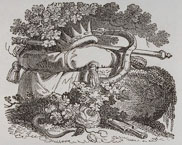Something
is rotten in the state of Denmark
By
Mary Ellen Dakin
Revere High School
Revere, MA 02151
 |
Introduction
In
literature as in life, even the most heroic characters are flawed, and
must struggle against their own weaknesses to achieve good. In this scene
from Hamlet, the Ghost will beckon his son to confront the moral
corruption that has destroyed him, and that threatens to engulf the prince.
In this lesson, students will reflect upon the power of corruption in
Hamlet’s world and in their own, and will discover variations in Shakespeare’s
text that influence both the characterization of Hamlet and the complexity
of the dual themes of evil and redemption.
|
Goals:
To understand the essential ideas in Hamlet’s speech through an analysis of
his language; to question, listen, and contribute to ideas in group discussion;
to compare textual variations and assess their impact on characterization and
theme; to compare and contrast several film performances, with sensitivity to
film’s verbal and nonverbal techniques.
Skills: critical thinking,
collaborative learning, close reading, and language analysis.
How long: 1-2 class periods.
Suggested
grade level: 9-12.
Lesson
1.
Review / preview: Ask students to explain Marcellus’s observation about
rot in Denmark, spoken at the end of 1.4, in relation to what they know so far
about the plot and characters in the play. Tell students that this simple line
also expresses one of the play’s major themes, and this is what the lesson today
will explore.

2. Unlocking
the language: Assign parts and read aloud from line 1 to 41, stopping at
Enter Ghost. After the first reading, instruct students to underline
words they do not understand. Because students need to pay close attention to
Hamlet’s speech (l.4.15-41), direct them to the explanatory notes that accompany
the text in the Folger edition. Tell students that for now, they should limit
their discussion of text to the meanings of individual words rather than whole
sentences.
3. Getting at theme through language
analysis: Write on the board or display on the overhead:
"The dram of
evil
Doth all the noble
substance of a doubt
To his own scandal."
Read aloud, several times, in several
voices.
Perform a demonstration for the class:
using a glass of water and an eyedropper, release red food coloring into the
glass, speaking Hamlet’s lines as you do so. Ask students to think about what
the demonstration might have to do with the words.
Another method of unlocking the language
in this line may be to ask students to identify the nouns and adjectives they
know. Underline those. You may get a sort of telegram that reads, "evil
/ noble substance / doubt / scandal." Point out that a "dram"
means a small amount of something.
Again, ask students to link the water
glass demonstration with the words. What is Hamlet saying about evil?
Ask students to think about other
ways of showing the idea in these lines. (Some possible suggestions might include
a worm in an apple, a tumor/alcohol/ drug in the body.) Tell students that they
are making metaphors and using imagery. (Briefly review the terms.)
Finally,
tell them they have created images of the nature of corruption, a key
idea in this scene and in this play.

4. Getting at theme through
reflection, writing, and discussion: To encourage reflection and to enrich
the classroom conversation, give students two minutes to respond in writing
to this prompt:
Do you agree that
a small amount of evil is enough to corrupt something good?
We all have flaws
and weaknesses: Are we doomed to failure because of them?
Begin by reading your own response.
Encourage students to read theirs aloud or to respond to the thoughts of their
peers.
It may be the case that in this classroom
conversation, some of your students may have rejected or modified Hamlet’s thoughts,
which is actually a perfect transition to the next part of the lesson.
5. Comparative reading of textual
variants: Ask students to scan Hamlet’s speech (l.4.15-41) for words, phrases,
or lines that soften the harsh message of evil and corruption and convey a more
hopeful, forgiving tone. For example, students may select lines 28-29, "As
in their birth (wherein they are not guilty, Since nature cannot choose his
origin)." Less able students may be encouraged to string together words
with positive connotations, such as "our achievements…performed at the
height…virtues…pure as grace."
Tell students that as they continue
to read Hamlet, a revenge play, they will need to watch what happens
to forgiveness in this play.
Visit the
Ramparts Reading Room with your students in search of Hamlet’s speech.
You will find that the speech you just studied is only in the Second Quarto!
Using the
First Quarto text, ask a student to read aloud from Horatio’s question (1.4.14)
to Enter the Ghost (1.4.42). Then refer students to the Second Quarto,
where Horatio’s question can be found at (1.4.14), to Enter Ghost at
(1.4.42). Have them read for comparison.
Ask students how the omission of
so much of Hamlet’s speech affects the scene. What is gained? What is lost?
(Students may note that while the plot speeds more efficiently toward the Ghost’s
dramatic entrance, Hamlet seems less thoughtful or less complicated.)
Extending
the lesson: Independently or during the next class period, send students
to the Hamlet on the Ramparts site to view art and production
stills for the 1.4 stage direction, "Enter Ghost." Just as students
analyzed texts for the themes of revenge and forgiveness, now they can collect,
compare, and analyze images for such elements as mood, imagery, and symbolism.
Links:
Full
Text of Hamlet 1.4 - 1.5
Mary
Ellen Dakin's Homepage
Mary
Ellen Dakin's Bio

